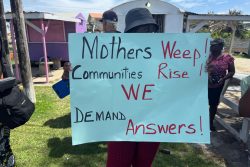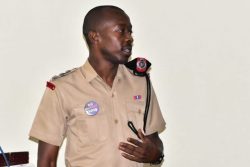The odds are that the mass of the population, located as it is on the coastland, paid little attention to the observances in relation to the Inter-national Year of Indigenous Languages, which concluded on December 31, 2019. It was the United Nations which declared how the year was to be commemorated, but it is reasonable to assume that not just here, but elsewhere in the world as well little heed was paid to the activities marking the past twelve months. This is despite the fact that of the 7,000 indigenous languages spoken worldwide, 2,680 are estimated to be in danger.
Guyana is fortunate in that it still has nine indigenous languages. There have been others in the past, but they either disappeared along with the people who spoke them, or their speakers left these shores. The classic example is that of the Tarumas, who moved into the south of Guyana from the Rio Negro in the 18th century to escape the Portuguese, and who effectively died out in the first part of the twentieth from a disease which was never diagnosed. It has been hypothesised that they were the last victims of the global flu pandemic which wreaked havoc after the First World War. Their few surviving members were absorbed by the Wapishanas, and their language is no more.
There were two other major linguistic extinctions here, which although they could be categorised as indigenous, were not so in an ‘Amer-indian’ sense. These were Skepi Dutch and Berbice Dutch, the first of which was spoken in Essequibo. They were Dutch Creoles, which interestingly were said not to be mutually intelligible, and were not easily understood by native Dutch speakers although they had a Dutch base. Skepi Dutch disappeared in the 19th century, but there were still a few speakers of Berbice Dutch around into fairly recent times. It was Professor Ian Robertson who initially brought the language to national attention and compiled the first basic vocabulary some decades ago, while Dutch scholar Sylvia Kouwenberg later pursued research on it, also interviewing the last few speakers, none of them young.
Certainly one would not wish our surviving nine indigenous languages to be referred to in the past tense as in the case of the Dutch Creoles, and one has to be concerned that some of them, at any rate, may be under threat. One of the more vulnerable ones is probably Arawak, or Loko, as it is more properly called, despite the fact that the largest Indigenous nation is Arawak.
Some years ago a GINA release reported that it was estimated there were about 15,000 Arawaks living in Guyana of whom only about 1,500 could still speak the language fluently. Most of those, it went on to say, were aged over 50. Considering that according to the 2012 census, Indigenous numbers have increased – they now represent 10.5% of the population – one must presume that Arawak numbers in absolute terms have increased along with them. Whether in addition the total of fluent speakers of the language is greater than it was, however, is very doubtful. Certainly, if a language is down to fifteen hundred speakers, or even one or two hundred more than that, its permanent viability would be in question.
There is nothing like having a language in written form to aid its survival, and at least all our indigenous languages have been committed to writing, admittedly some much more recently than others. It is the Christian churches, in particular, which have played a major role in this, a service which should be acknowledged, whatever critics have said against missionisation in principle. Inevitably, particularly in the earlier period, individual ministers of religion devoted much energy to translating portions of the Bible into a given indigenous language in order that converts could read it for themselves.
The tragedy about Arawak is not just that it has existed in written form for a long time, but that it also boasts some notable linguistic scholars who have worked on it. The Arawaks have been in contact with Europeans for around 450 years, first with the Spaniards in the island of Margarita, and then the Dutch and English. It is the latter, however, who compiled the earliest known Arawak word list in Trinidad in the 1590s, and the Spanish followed suit in the initial quarter of the 17th century. The first linguist to apply his talents to the language was the German, Theophilus Schumann, who worked with the Moravians in Berbice in the mid-eighteenth century evangelising the surrounding nations, particularly the Arawaks. In addition to some biblical translations he also produced a dictionary and grammar.
Schumann, however, died in 1760, and his missionary companions fled on the outbreak of the 1763 Uprising. It was a group of Moravians working on the Corentyne at the end of the 18th century who took up the work and encouraged literacy among the Arawaks they taught, producing an Arawak ABC and spelling book for them.
In the 19th century under the British, the translations of the gifted linguist W H Brett, who worked in more than one indigenous language, are considered outstanding, more particularly as these relate to the Bible. Canon John Peter Bennett, a linguistic scholar of the language, and himself an Arawak, described the translations as “beautiful”. Brett, of course, relied heavily on native speakers, and made reference to his indebtedness to a woman in particular, whose expressive and eloquent articulation of her mother tongue made such a contribution to his work.
Canon Bennett himself was described by Prof Robertson as “one of the most significant people I have met in my time in the field of linguistics.” Con-cerned about the retreat of the Arawak language, he directed his endeavours to the compilation of an Arawak-English Dictionary, a teaching guide with 28 lessons in Loko/Arawak, the translation of some of the Gospel books into Arawak and the publication of ‘The Arawak Language in Guyanese Culture’, among other works.
Cultural expression in all its forms is closely tied to language, supplying the structure for our perceptions of the environment around us, and emerging from that, our larger world view.
If the language goes, therefore, an essential component of our cultural definition and our understanding of our universe goes with it. This was illustrated in one small, but tangible way when Canon Bennett was able to interpret the symbols on Indigenous petroglyphs for archaeologist Denis Williams, who included them in his seminal work on the subject.
In this country the International Year of Indigenous Languages concluded two weeks ago with a debate in Paramakatoi which was conducted exclusively in Patamona. The somewhat wordy moot for the debate was, ‘Indigenous languages hold tremendous benefits, not just for Indigenous peoples but for all Guyanese, hence it’s the responsibility of the government to ensure that the languages are preserved and promoted nationally.’
It might be noted that it takes more than a government to ensure the survival of a language which is under pressure from a dominant tongue, which is not to say that it does not have a role. However, the people themselves must also want to preserve their linguistic inheritance and the cultural perceptions inherent in that; success cannot be had simply through the actions of external agencies. At one time the Arawaks in a part of the North-West committed to what was known as the Capoey Project, in which village children aged 4-10 were to be taught Arawak. How successful that was, however, and whether it has survived has not really come to public notice.
The Department of Public Information had reported at the beginning of last year that $36 million had been allocated in the 2019 national budget to promote the nine Indigenous languages through collaboration with the UN. A list of ambitious objectives followed, many of which were no doubt helpful to various communities. In the end, however, ensuring the sustainability of a language is not a one-off, twelve-month venture; it is an ongoing challenge which requires continued effort.
At one time – and one hopes it is still extant – the Ministry of Education had introduced a project to teach young Wapishana children in their own language at the primary level with the aim of improving literacy levels. It was reported at one stage that this had achieved some success. It should perhaps be noted that the experience of the UK in the case of some of its minority languages, is that the school system is the preferred route for revival.
If Indigenous languages disappeared it would not just represent a loss for the nations involved; it would be a loss for all of us. They are a part of the Guyanese heritage, and our local world and experience would be diminished without them.









